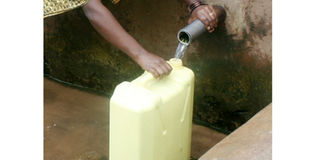One in 200 city wells is safe - KCCA

A woman collects water from a well in Bukasa, a Kampala suburb, recently. PHOTO BY FAISWAL KASIRYE
What you need to know:
City authorities now say lives of upto two million people are at risk of contracting diseases like typhoid, cholera.
Kampala
Most city water sources are unsafe for both human and animal consumption, a senior health official has said.
The Kampala Capital City Authority (KCCA) Public Health and Environment Officer, Dr James Ssemuwemba, said this is contained in a recent survey that was conducted. “We found out that out of more than 200 wells in Kampala, one passed the yardstick of safe water,” Dr Ssemuwemba said in an interview with this newspaper recently. He added: “50 per cent of pit-latrines in the city suburbs were abandoned, putting at risk people’s lives and easing infiltration of feces into the waters.”
The Ministry of Water and Environment report last year showed a similar trend. The report indicated that up to 85 per cent of the protected spring wells in Kampala are still contaminated with faecal matter, yet, more than 90 per cent of slum dwellers, get their water from these spring wells.
Dr Julian Kyomuhangi, the assistant commissioner for environment health in the Ministry of Health, said the recommended distance between a water source and a pit-latrine is 100 metres. “But because in Kampala, the situation is different, getting a distance of that nature is very difficult,” she said in a telephone interview yesterday.
She added: “In urban areas we are supposed to have piped water and not spring wells or boreholes.”
Kampala is home to about two million people in the night, a figure that rises upto about three million in the day.
People using unprotected wells risk contracting water borne diseases such as diarrhea, cholera, typhoid fever and dysentery.




